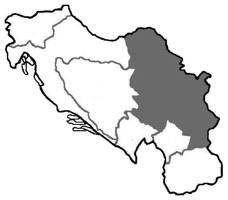
|
The Society of Folk Dance Historians (SFDH)
About Orijent
[
Home |
About |
Encyclopedia | CLICK AN IMAGE TO ENLARGE |

|
 The Serbian Kolo, Orijent, has been among the top forty in folk dance circles for several years now, in numerous variants and interpretations. As a folk dancer travels from one coast to the other, he finds that once he has learned the two or three different sequences currently being done around the country, his visits to various groups will be quite comfortable, and that he can fit in almost anywhere when the Orient record is put on. If a native Serb dancer were to make that same trip, however, he would be pretty baffled – either he wouldn't recognize his dance, or he would find it extremely painful to stay in the line very long.
The Serbian Kolo, Orijent, has been among the top forty in folk dance circles for several years now, in numerous variants and interpretations. As a folk dancer travels from one coast to the other, he finds that once he has learned the two or three different sequences currently being done around the country, his visits to various groups will be quite comfortable, and that he can fit in almost anywhere when the Orient record is put on. If a native Serb dancer were to make that same trip, however, he would be pretty baffled – either he wouldn't recognize his dance, or he would find it extremely painful to stay in the line very long.
Given the fact that an evening program in the average group consists of several dozen dances from as many ethnic origins, it is not surprising that a kind of homogenization of style has occurred among American folk dancers: having borrowed dances from many diverse sources, we tend to dance everything with the same style – in a sense, we have our own village. And John Q. Folkdancer, with everything else he has to do, can hardly be expected to devote the time necessary to mastering several dozen different ethnic dance styles. Besides, everyone dances for different reasons, and John Q. may simply be interested in losing weight – criticisms of his styling may be totally irrelevant to him.
This article on the dance Orijent is aimed at those dancers who would like to reproduce the original native dance styling as closely as possible and who are interested in Orijent from the point of view of its cultural setting. I have the feeling that the number of such dancers would increase if the backgrounds of more folk dances were better known.
I first witnessed Orijent in the village of Železnik in Serbia on an Easter Sunday, 1954. It was a splendid sunny day, and villagers from Železnik and surrounding areas had gathered on an immense field to celebrate. I guess there were several thousand. Many kolo circles polka-dotted the field, each practically crushed in by the sea of on-lookers. As I pushed my way from one circle to another, I noted that most were dancing some form of U šest, occasionally a circle was doing Šetnja, but many more were doing a kolo I was informed was called Orijent. As the afternoon wore on, I noted down about a half dozen varients of Orijent, this fascinating dance I had never seen before.
Of the many variants of Orijent that I observed in Železnik and other places, I picked three and combined them in a fixes sequence for use in a stage choreography I was preparing in 1956 for the Duquesne University Tamburitzans. This little three-figure sequence later spread around the United States among recreational folk dancers. It is in a sense artificial, of course, since in its native setting Orijent would never be seen in a fixed sequence. Its usefulness in this form is to give American folk dancers, unused to improvising in a foreign idiom, a chance to savor the dance in several of its variants.
In its native setting, Orijent is performed without a conscious shift from one "figure" to another – it is a fluid affair, generally guided by the leader, who performs the same two-measure pattern over and over again, embellishing it now and then with an improvised movement. The others in the line do not attempt to imitate him – the idea is the same as in U šest: individual variation on a basic pattern without disturbing neighboring dancers.
Structurally, Orijent is something of a puzzler among dancers in this area of Serbia. First, whereas other dances begin with the right foot, all the variants of Orijent begin with the left, though the over-all movement of the dance follows the Serbian "rule of the thumb" in moving right (counterclockwise). Secondly, the entire pattern of any given variant is two measures long – a feature which, though not unknown in Serbian dances is rare in the present-day Šumadijan repertory. Also, the name "Orijent" is puzzling. It means (you guessed it) "Orijent" and is not a native word. The only feasible interpretation is that it is somehow related to the famous Orient Express that passes through this area on its way to İstanbul. Native dancers readily informed me that the dance is of Rom origin, though now done widely by non-Rom Serbs. For this reason it is sometimes called Ciganski Orijent ("Rom Orijent").
Though unique in several ways, Orijent is nevertheless done in the typical local style. This style is sometimes called the "Šumadijan" style, named after Šumadija, the broad heartland area south of Beograd (Belgrade). Other dances in Šumadijan style are Šetnja and U šest. It is a style that has spread out all over the rest of Serbian in recent years.
Individuals vary, of course, but in general Šumadijan style can be summed up as follows:
- Very straight posture from the knees up.
- What the Serbs call "makano koleno" ("soft knee") – by which they mean that the flexions of the knee cause a firm but gentle up-and-down movement of the body as a whole – a kind of subtle rhythmic bobbing.
- Though movements on the flat of whole foot are often seen, Šumadijan dancers usually tread on the forward portion of the foot. Heel contact with the ground is incidental.
- Dominance of vertical movement over horizontal: the dancer tends to cover very little ground, preferring to turn his energies inward rather then dissipate them in larger steps in space. True, he may fling his feet up in back, or make a slicing step down in front or back from a considerable height out the side, but these flings and slices are practically in place – he doesn't travel great distances on any given step.
In American renditions of Orijent, by the way, it is this fourth feature that is most "violated." American folk dancers seem to respond to the call "charge!," and whip halfway around the floor in a wild, "liberated" interpretation of the first figure!
DOCUMENTS
- Balkans, a region.
- Dick Crum, an article.
- Serbia, a country.
- Yugoslavia, a former country.
This page © 2018 by Ron Houston.
Please do not copy any part of this page without including this copyright notice.
Please do not copy small portions out of context.
Please do not copy large portions without permission from Ron Houston.